Recency bias is difficult to overcome and must be acknowledged when evaluating fantasy baseball players. A good case study? First half/second half splits. It may seem like we are falling into the trap of recency bias of valuing what a player does in the second half more than the first half. At the same time, players make legitimate changes and adjustments throughout the season, which can carry over to the following season.
In my opinion, these six hitters made legitimate changes that helped unlock their true potential. If all goes as planned, they’ll perform much closer to their second-half stats, as opposed to their overall stats from last season; they can be strong values in 2022 fantasy baseball drafts. Who are these six players? Let us get right into it!
ADP Data via NFBC.com
Brandon Lowe
ADP: 85
After posting a 152 weighted-runs-created-plus (wRC+) in the shortened 2020 season, there was a lot of optimism that Brandon Lowe would continue to be one of the premier offensive second basemen in 2021. After all, he decreased his strikeout rate from 34.9% to 25.9%, allowing for him to maintain a solid batting average (.269), despite a massive decrease in batting average on balls in play (BABIP).
Unfortunately, with a 32.2% strikeout rate in the first half, Lowe didn’t initially make good on those hopes. He still mustered a 116 wRC+, but his batting average (.208) made him a liability in category leagues, while the strikeouts hurt his value in points leagues. On the bright side, this all turned around in the second half:
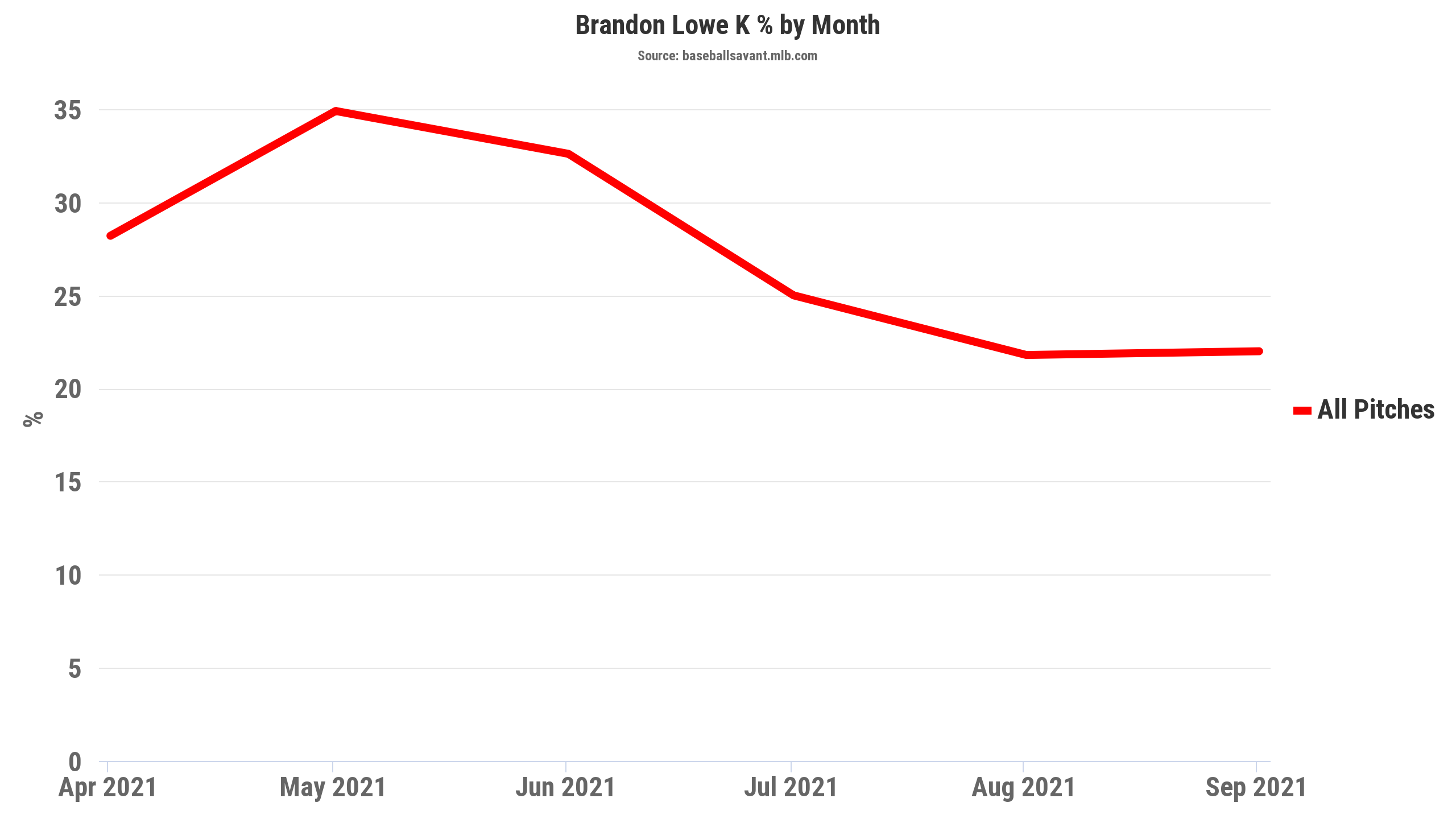
With an increase in contact, Lowe’s batting average soared to .291 in the second half. Some of this is due to positive regression in his BABIP, but there seems to be an approach change that could make the decrease in Lowe’s strikeout rate legitimate. Here are his in-zone swing rates per month:
- April: 73.7%
- May: 74.2%
- June: 76.2%
- July: 80.8%
- August: 83%
- September: 83.4%
By being less passive, Lowe was able to avoid the two-strike situations that made him susceptible to poor outcomes. Given his subpar contact skills, the more he can be aggressive early in the count, the better. Heading into 2022, you should expect Lowe to not be a liability in the batting average department but to continue to provide the power that you drafted him for. That sounds like the ideal starting second baseman to me!
Joey Votto
ADP: 163
Heading into the season, Joey Votto made his intentions clear: he wanted to get back to “being dangerous,” according to the AP News.
“I lost some of my strengths that I first came to the league with — hitting the ball all over the field with power, being difficult to defend,” Votto said. “I did that in exchange for command of the strike zone, putting the ball in play, being a tough at-bat. And it zapped my power”
With a 113 wRC+, Votto was an effective hitter, but not quite to the levels he was hoping for. Now, his power (.206 isolated power) was much better than previous seasons, but his .347 on-base percentage wasn’t on par with where you’d expect it to be.
So, what did Votto do? He started to hit the ball in the air. Here are his fly ball rates by month, excluding May, where he only had 14 plate appearances:
- April: 31.1%
- June: 26.4%
- July: 44.8%
- August: 43.5%
- September: 41.9%
This coincided with a massive power increase. Votto’s .383 isolated power (ISO) ranked second in the second half. Furthermore, with more power came fewer pitches in the zone, allowing him to post a 17.2% walk rate. As long as Votto continues to lift the ball, he’ll continue to hit for power, which will also allow him to exercise his tremendous plate discipline as pitchers avoid throwing him pitches in the zone. Even at his age (38), I’d bank on him continuing to be dangerous in 2022.
For more on Votto’s excellent 2021 season, here is a complete breakdown.
Ian Happ
ADP: 189
Early in his career, Ian Happ did not exactly have consistent playing time with the Cubs. However, when on the field, he made the most of his opportunities. In 156 plate appearances in 2019, he posted a 126 wRC+ and followed that up with a 130 wRC+ in the shortened 2020 season. I can speak for myself when I say that I was a complete believer in his skillset heading into 2021.
In the first half, that did not come to fruition. Happ posted just a 73 wRC+ with a .183 batting average, likely causing his fantasy managers to drop him. If you did happen to hold onto Happ, however, you were quite pleased with what took place in the second half. The 26-year-old rebounded to a 133 wRC+ and .268 batting average, in addition to a .268 ISO. Essentially, he became the player he was previously; it just took a half to get there.
So, what caused the massive bounce back. In my opinion, this looks like a case of simple regression. Line drives are the optimal trajectory of contact but are very difficult to hit at a sustainable level. In fact, based on my research, it is one of the more unsustainable hitting metrics from season to season, even more so than BABIP. After further review, this was the major roadblock that got out of the way in the second half:
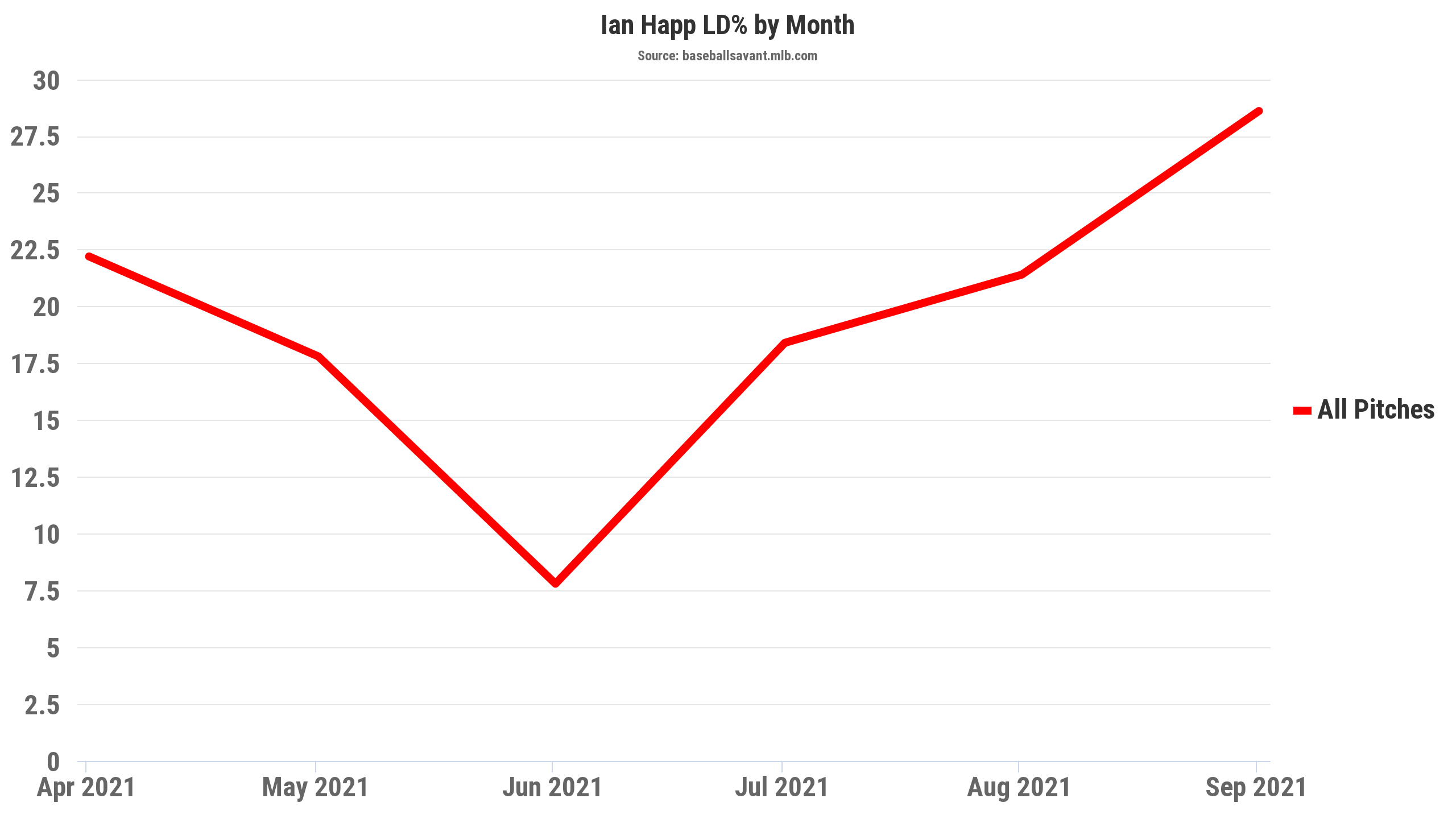
After posting a .231 BABIP in the first half, Happ posted a .331 BABIP in the second half and hit for more power as well- he had a 12.5% barrel rate in August and a 16.1% barrel rate in September. Whereas the rest of these players made a specific change to reach their potential in the second half, Happ was just a victim of poor luck in the first half. I’m fully expecting the second-half version of him heading into 2022, making him a value at his current average draft position.
Jorge Soler
ADP: 190
The top gainer in wRC+ from the first half to the second half? That would be World Series MVP Jorge Soler. You’re likely familiar with the 29-year-old’s prowess in the World Series, but did you know he posted just a 65 wRC+ in the first half? That’s quite the turnaround!
To be fair, that was a lot that did not go Soler’s way in the first half. His .243 BABIP was on the low side, while his 8.6% home run/fly ball rate was extremely low. Even before being traded from the Royals to the Braves, there were signs that Soler’s home run luck was turning around, and he ultimately posted a 24.7% HR/FB rate in the second half.
However, this wasn’t just a case of positive regression; Soler made some changes as well. As a result of making more contact, particularly in the zone, his strikeouts went in a favorable direction:
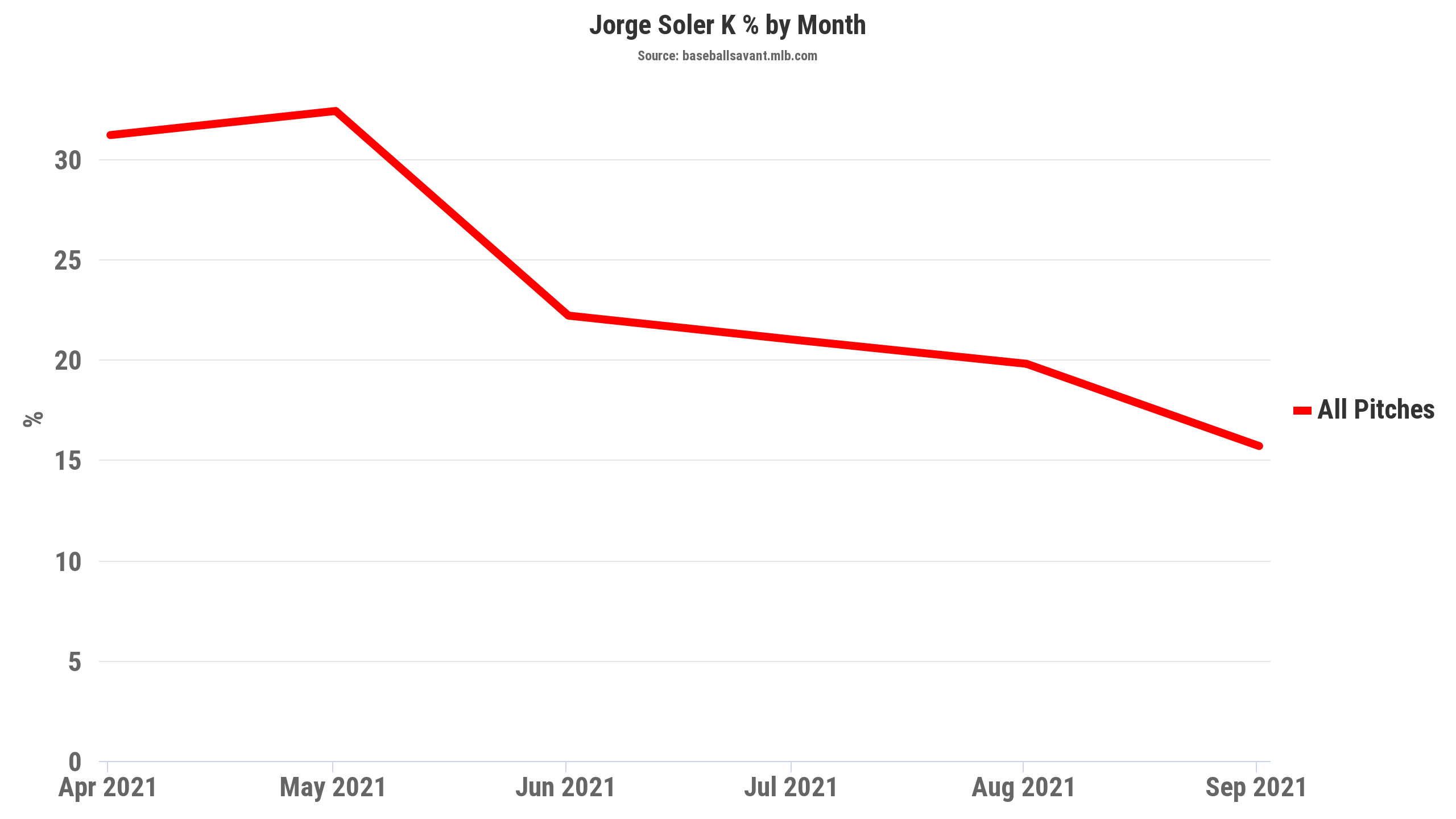
As a result, Soler boosted his batting average from .186 in the first half to .263 in the second half. Overall, his 23.6% strikeout rate was a career-low rate, while his .223 batting average should improve with positive BABIP (.250) regression. We’ll wait to see what his role is with his new team, but with the universal designated hitter likely coming, he’s in a good spot. I’d definitely consider him someone you should have starred on your draft board in 2022; the power and improved contact skills are a great combination to build on.
Brandon Belt
ADP: 220
When you post a 136 wRC+ in the first half, you shouldn’t show up on a list focusing on the hottest second-half hitters. However, Brandon Belt is the exception. Why? Here are the hitters that had a better second-half wRC+ than him
- Bryce Harper (201 wRC+)
- Juan Soto (199 wRC+)
That’s it. In other words, Belt was an absolute mad man in the second half. His .394 ISO led all hitters during that span, while he also posted a .297 batting average, .394 on-base percentage, and .444 weighted-on-base-average (wOBA). The key? The biggest drop-off in strikeout rate (11.2%) from the first half (32.3%) to the second half (21.1%). Take a look at his in-zone contact rates per month:
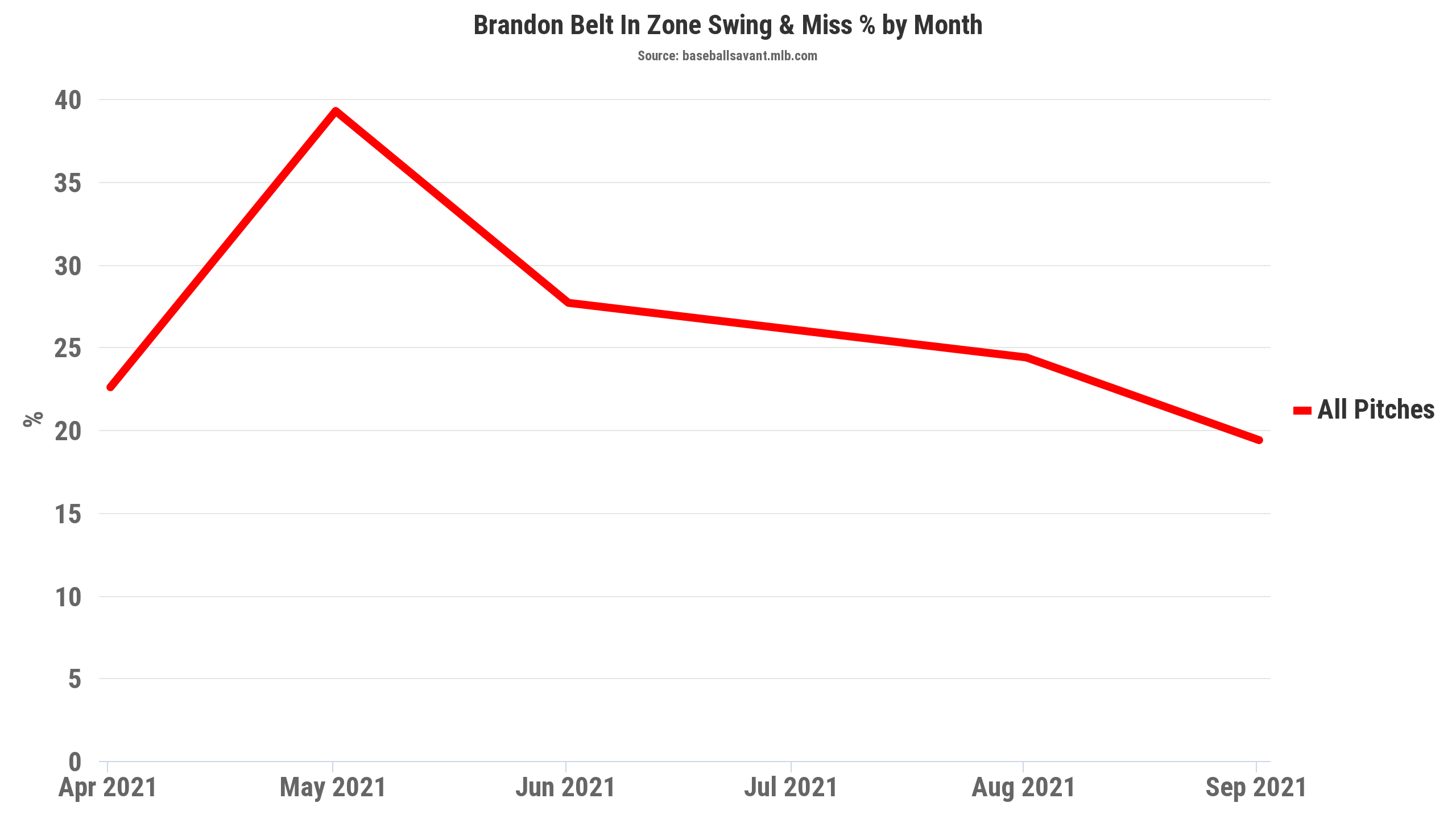
Belt’s strikeout rates generally hover around 20%, so we can look at that improvement in the second half as getting back to normal. The key is the power improvement, which has really been notable over the past two seasons:
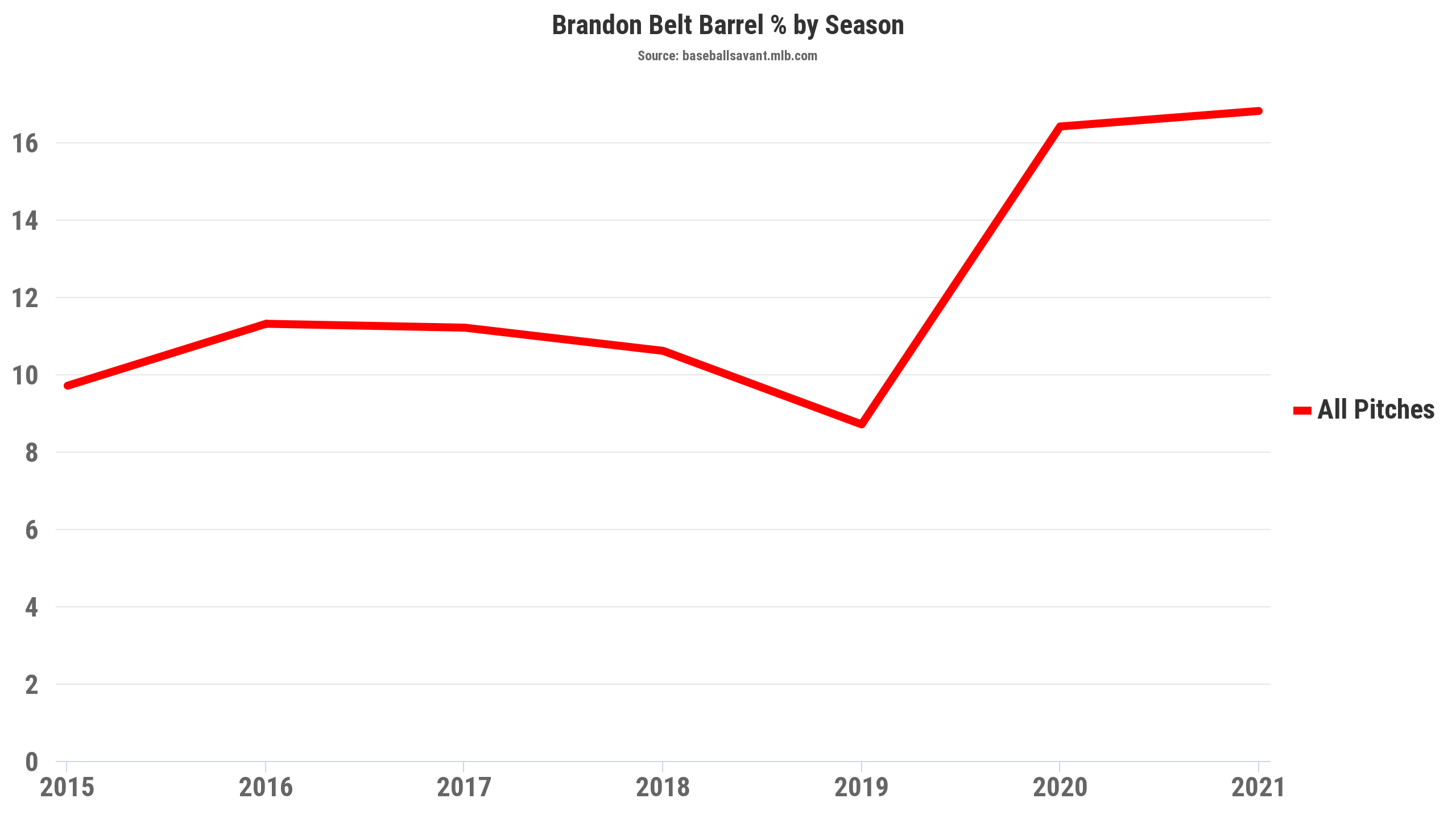
With a current average draft position of 220, Belt is an absolute steal. Yes, his durability is always in question, but he’ll provide you with a lot of power with a decent-enough batting average. If you want to wait on a first baseman, he’s a great late-round target. Hopefully, “The Captain” continues to perform at a high level in 2022.
Bobby Dalbec
ADP: 229
Jorge Soler had the greatest wRC+ improvement from the first half to the second half, but just one wRC+ behind him was Bobby Dalbec, who had quite the roller-coaster season in 2021.
With just a 76 wRC+ in the first half, Dalbec appeared to fail to capitalize on the chance to be Boston’s first baseman not just for 2021 but for years beyond that. When the team acquired Kyle Schwarber, that only appeared to be more clear. However, Schwarber needed more time to heal from his injury, and Dalbec took full advantage.
Really, there is no aspect that Dalbec didn’t improve from the first half to the second half:
- wRC+: 76 to 149
- K%: 36.8% to 31.3%
- BB%: 4.7% to 8.2%
- ISO: .190 to .343
This would appear to be an example of a young player adjusting to MLB pitching, but Dalbec also made a specific adjustment to help him. As a player without strong contact skills, avoiding two-strike counts is a focus; being less defensive leads to more power, and fewer strikeouts means more opportunities to get on base and hit for average. Well, Dalbec appeared to take note:
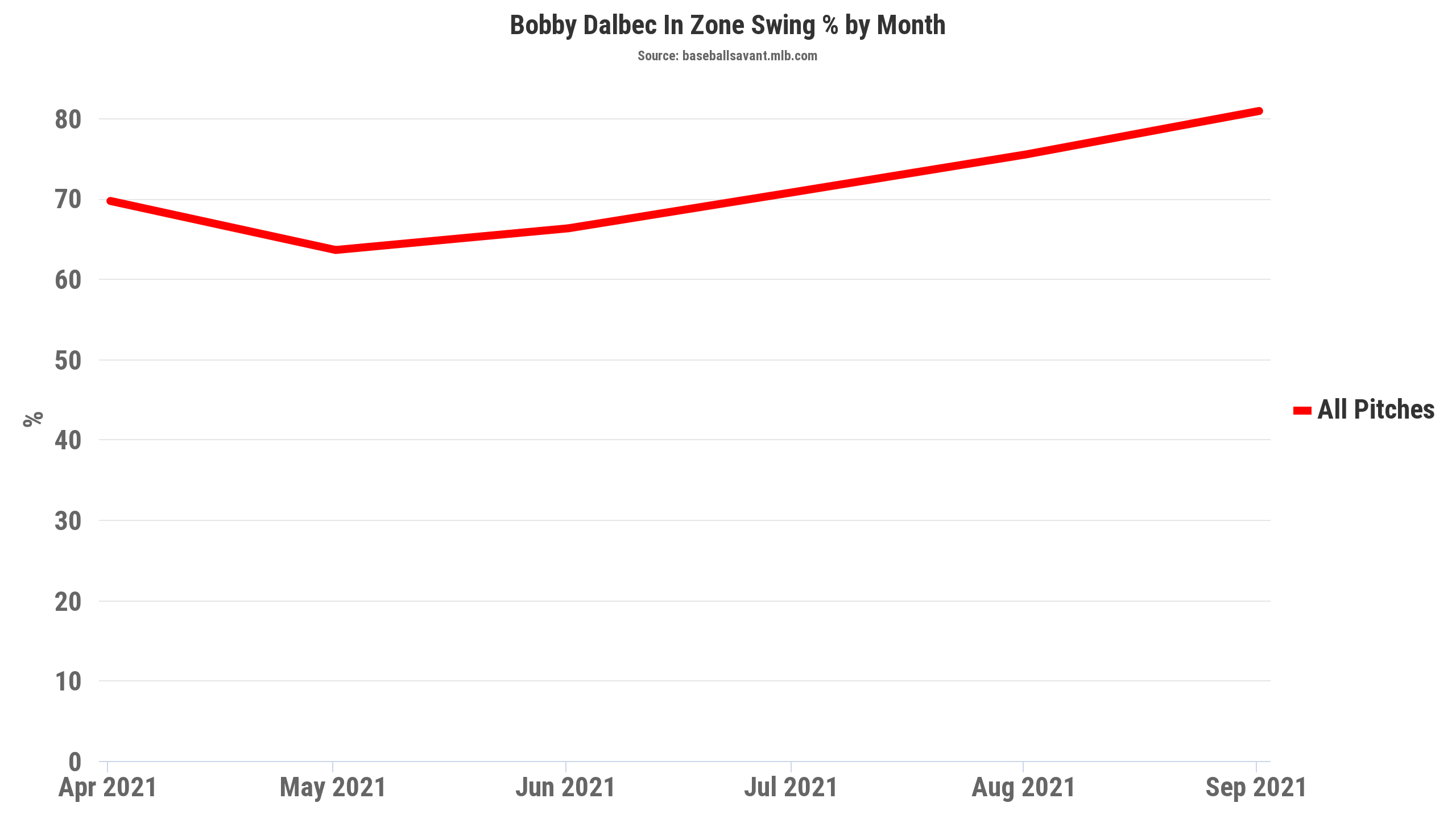
Similar to Lowe, less passiveness is a plus for a player who struggles to make contact. I’m buying Dalbec’s improvements as a power hitter and believe Boston should feel comfortable with him as their starting first baseman in 2022. Is it a given that he’s able to produce with a strikeout rate over 30%? Nope, but a high strikeout rate is not a reason to give up on a hitter. In the 15th round in 15-team drafts, he’s a high-upside bench stash that I certainly would be looking to make, and I’d target him in dynasty leagues before his stock rises further.
Photos by Icon Sportswire | Design by J.R. Caines
